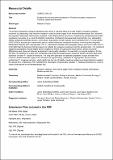Por favor, use este identificador para citar o enlazar a este item:
http://hdl.handle.net/10261/320601COMPARTIR / EXPORTAR:
 SHARE SHARE
 CORE
BASE CORE
BASE
|
|
| Visualizar otros formatos: MARC | Dublin Core | RDF | ORE | MODS | METS | DIDL | DATACITE | |

| Título: | Evidence for the long-term resistance of Posidonia oceanica meadows to Caulerpa cylindracea invasion |
Autor: | Bernardeau-Esteller, Jaime; Marín-Guirao, Lázaro CSIC ORCID ; Sandoval-Gil, José Miguel; García-Muñoz, María del Rocío; Ramos-Segura, Aránzazu; Ruiz-Fernández, Juan Manuel | Palabras clave: | Centro Oceanográfico de Murcia Medio Marino |
Fecha de publicación: | ene-2020 | Citación: | Aquatic Botany, 160. 2020: 1-8 | Resumen: | The invasive seaweed Caulerpa cylindracea has shown a reduced ability to invade healthy Posidonia oceanica meadows by penetrating only meadow margins in early invasion stages in the western Mediterranean Sea. However, the long-term interaction with invasive seaweed could deteriorate the structure of meadows by diminishing their initial resistance to invasion as a result of potential competitive mechanisms between both macrophytes (e.g. allelopathic effects, enhanced sediment anoxia). In this study, populations of both species were monitored over a 10-year period (2007–2016) in invaded and non-invaded sites to assess meadows’ resistance evolution to the presumed long-term negative interactions between both macrophytes. The C. cylindracea biomass in the seagrass canopy was much lower (from 5- to 60-fold) than the biomass that developed just outside the seagrass meadows at all the invaded sites. The monitored seagrass populations showed stable and/or progressive trends throughout the study period, and no structural differences were observed between invaded and non-invaded meadows. To conclude, our results evidence, for the first time, the absence of a long-term competitive interaction between invasive seaweed and the structure and shoot dynamics of native P. oceanica meadows. The long-term presence of persistent gradients of algal biomass from outside to inside meadows supports the existence of highly limiting conditions for algal growth and survival in undisturbed P. oceanica canopies, what reinforces the role of healthy meadows acting as ecological barriers against the spread of C. cylindracea. This highlights the importance of conserving valuable P. oceanica meadows as a way to control bioinvasions in the Mediterranean Sea. | URI: | http://hdl.handle.net/10261/320601 | DOI: | 10.1016/j.aquabot.2019.103167 | ISSN: | 0304-3770 |
| Aparece en las colecciones: | (IEO) Artículos |
Ficheros en este ítem:
| Fichero | Descripción | Tamaño | Formato | |
|---|---|---|---|---|
| AQBOT_2019_63_AcceptedVersion.pdf | 5,63 MB | Adobe PDF |  Visualizar/Abrir |
CORE Recommender
SCOPUSTM
Citations
7
checked on 03-may-2024
WEB OF SCIENCETM
Citations
4
checked on 15-feb-2024
Page view(s)
16
checked on 08-may-2024
Download(s)
22
checked on 08-may-2024
Google ScholarTM
Check
Altmetric
Altmetric
NOTA: Los ítems de Digital.CSIC están protegidos por copyright, con todos los derechos reservados, a menos que se indique lo contrario.
